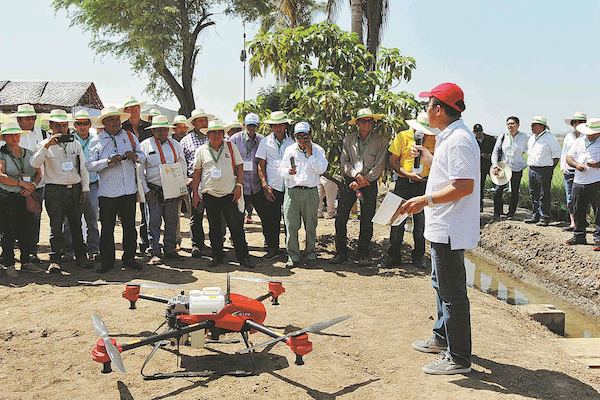Agricultural drone makers eye overseas markets

Chinese entrepreneur Ma Zhiqiang explains the use of an agricultural drone to farmers in Ecuador. Photo provided to CHINA DAILY
Efforts accelerated
Yang Jincai, director of the Shenzhen Unmanned Aerial Vehicle Industry Association in Guangdong, said: "China is at the forefront of state-of-the-art farm-specific drones, which are the fastest-growing and most widely used industry-level drones."
Domestic drone manufacturers have stepped up efforts to venture overseas in view of the huge demand for advanced and intelligent agricultural equipment and technologies, Yang said, adding that he is bullish about the prospects for agricultural drones.
He said that in addition to agriculture, industry-level drones are likely to be used for mapping, public security, logistics, power line patrols, emergency rescue work and disaster relief, and such applications will witness huge growth.
"More efforts are needed to improve after-sales services in overseas markets and strengthen cooperation with global drone industry associations to cultivate professional pilots and create additional job opportunities for local people," Yang added.
Meanwhile, DJI, the world's largest commercial drone manufacturer by market share, has also invested heavily in developing agricultural drones, with the aim of helping farmers improve efficiency and increase the use of intelligent agricultural equipment.
The company, which is based in Shenzhen, has expanded its presence in international markets since 2016. Its agricultural drones have been deployed in more than 40 countries and regions, with shipments surpassing 20,000 units.
DJI has expanded relatively quickly in Japan and South Korea, accounting for 60 percent to 70 percent of the farm drone market in these two countries. Its agricultural products also perform well in Southeast Asia and Latin America, both of which have good growth potential.
Chen Tao, global marketing and sales director of DJI's agricultural equipment department, said, "With rising per capita income and a shrinking agricultural labor force, demand for modern agricultural machinery has grown significantly, especially in Southeast Asia."
Despite the pandemic overseas, sales of DJI's agricultural drones doubled last year, Chen said. He is optimistic about the prospects for such drones, as there is huge demand for the devices and the entire industry is "still in exploration mode".
"We will formulate a diversified expansion strategy catering to the needs of local users, especially in Southeast Asia. For instance, we will strengthen construction of localized sales channels and service capacities, to expand our business and enhance the level of local agricultural machinery," Chen said.
He added that overseas revenue from agricultural drones is expected to more than double that of the domestic market, calling for improved technology and more input sources to achieve the large-scale use of these devices.
Last year, the Ministry of Agriculture and Rural Affairs donated 12 T16 farm drones made by DJI to Pakistan to help the country combat locusts and protect food security.
Pakistani farmers struggled to combat the worst locust swarms in nearly three decades as the insects ruined harvests in the country's agricultural heartlands, sending food prices soaring.
A DJI T16 farm drone can spray insecticide over 10 hectares of land every hour, and the devices will increase Pakistan's ability to prevent locusts spreading to desert areas.
Lan Yubin, a professor from South China Agricultural University, said that in recent years agricultural drones have played a vital role in promoting smart agriculture worldwide.
He added that drone technologies have grown rapidly and fierce competition in the market is driving prices down.



 Print
Print Mail
Mail

